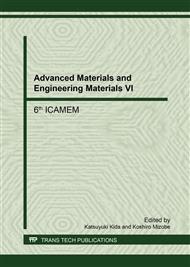[1]
ZH Zhang, ANSYS10 Thermal analysis tutorial and example analysis, China Railway Press, Beijing, (2007).
Google Scholar
[2]
EL YU, Y Han, Y Fan, Y Zhao, Simulation of coupling of electromagnetic and thermal fields for process of high-frequency induction heating of HFW pipe, Transactions of the China Welding Institution, 31(2010)5-8.
Google Scholar
[3]
Y Han, EL Yu, Numerical Analysis of a High-Frequency Induction Welded Pipe, Welding Journal, 91(2012) 270S-277S.
Google Scholar
[4]
XD Liu, ZW Wang, H Chen, Simulation of Temperature Field in High Frequency Induction Welding Process of Composite Aluminum Alloy Thin-Walled Tube, Applied Mechanics & Materials, (2015)713-715.
DOI: 10.4028/www.scientific.net/amm.713-715.2864
Google Scholar
[5]
S Feli, MEA Aaleagha, M Foroutan, EB Farahani, Finite Element Simulation of Welding Sequences Effect on Residual Stresses in Multipass Butt-Welded Stainless Steel Pipes, Journal of Pressure Vessel Technology, 134(2012) 897-904.
DOI: 10.1115/1.4004571
Google Scholar
[6]
D Deng, H Murakawa, Numerical simulation of temperature field and residual stress in multi-pass welds in stainless steel pipe and comparison with experimental measurements , Computational Materials Science, 37(2006) 269-277.
DOI: 10.1016/j.commatsci.2005.07.007
Google Scholar
[7]
Hyun-Jung Kim, Sung-Kie Youn, A Computational Study on the High Frequency Induction Welding Phenomena, Proceedings of the first International Conference on computational methods in Engineering Science and mechanics(2006).
Google Scholar
[8]
M Abid, M Siddique, Finite-element simulation of tack welds in girth welding of a pipe-flange joint, Acta Mechanica, 178(2005)53-64.
DOI: 10.1007/s00707-005-0241-3
Google Scholar
[9]
J Zhang, H Xiong, X Yang, Numerical Simulation on the Welding Stress-strain of 5454 Aluminum Alloy Pipe Girth , Hot Working Technology, 41(2012)128-130.
Google Scholar
[10]
A Nikanorov, E Baake, J Neumeyer, Numerical Simulation and Investigation of High Frequency Tube Welding Process, Applied Mechanics & Materials, 698(2014)245-250.
DOI: 10.4028/www.scientific.net/amm.698.245
Google Scholar
[11]
FZ Shi, MA Jian-Guo, YJ Chen, Research on Relativity Between Characteristics of Heat Affect Zone and Quality of Welded Pipe for ERW Pipe, Welded Pipe & Tube, 30(2007) 60-62.
Google Scholar
[12]
Z Tan, Engineering alloy thermal physical properties, Metallurgical Industry Press, Beijing, (1994).
Google Scholar
[13]
F Liu, The research on parametric simulation of high-frequency welded pipe and its advantages in practical based on ANSYS, Lanzhou University of Technology, (2011).
Google Scholar
[14]
Specification for Welded Copper and Copper-Alloy Heat Exchanger Tube, ASTM B543, (1996).
Google Scholar
[15]
Aluminum and Aluminum Alloy Welded Pipes and Tubes, JIS H4090, (1990).
Google Scholar


